Developing a New HSR Switching Node (SwitchBox) for Improving Traffic Performance in HSR Networks
Abstract
:1. Introduction
2. Background
2.1. High-Availability Seamless Redundancy (HSR) Concepts
- Doubly attached node for HSR (DANH): A DANH node is an HSR-capable switching end node that has two HSR ports sharing the same medium access control (MAC). These two ports form a single interface. The source DANH inserts the HSR tag into the frame received from upper layers, duplicates the frame into two frame copies and sends the two copies over both ports. The destination DANH receives two copies of the same frame, one from each port.
- Redundancy Box (RedBox): Singly attached nodes (SAN), such as servers, maintenance laptops or printers cannot be directly connected to an HSR ring, since they have no HSR forwarding capability and do not support the HSR tag. A RedBox is used to connect SANs to the HSR ring. RedBoxes forward the frames over the ring like DANH nodes and act as proxies for all SANs that access them.
- Quadruple port device (QuadBox): QuadBox nodes are used to connect HSR rings together. A QuadBox has four HSR ports that are divided into two pairs connected by an interlink; each pair shares the same MAC. QuadBoxes operate as HSR nodes toward both rings simultaneously. Although one QuadBox is sufficient to conduct the traffic in a fault-free network, two QuadBoxes are used to prevent a single point of failure [8].
2.1.1. Single-Ring Networks
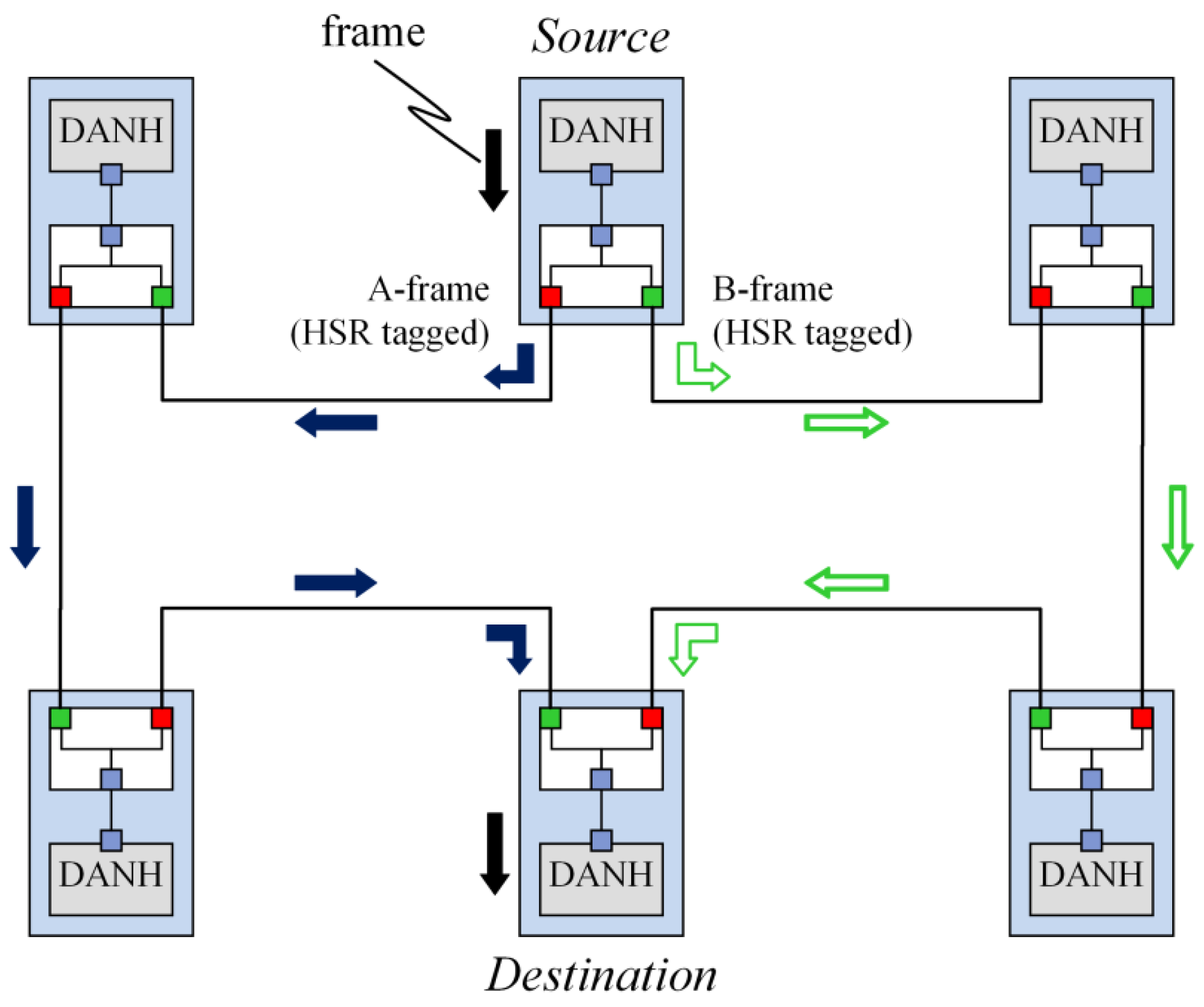
2.1.2. Connected-Ring Networks
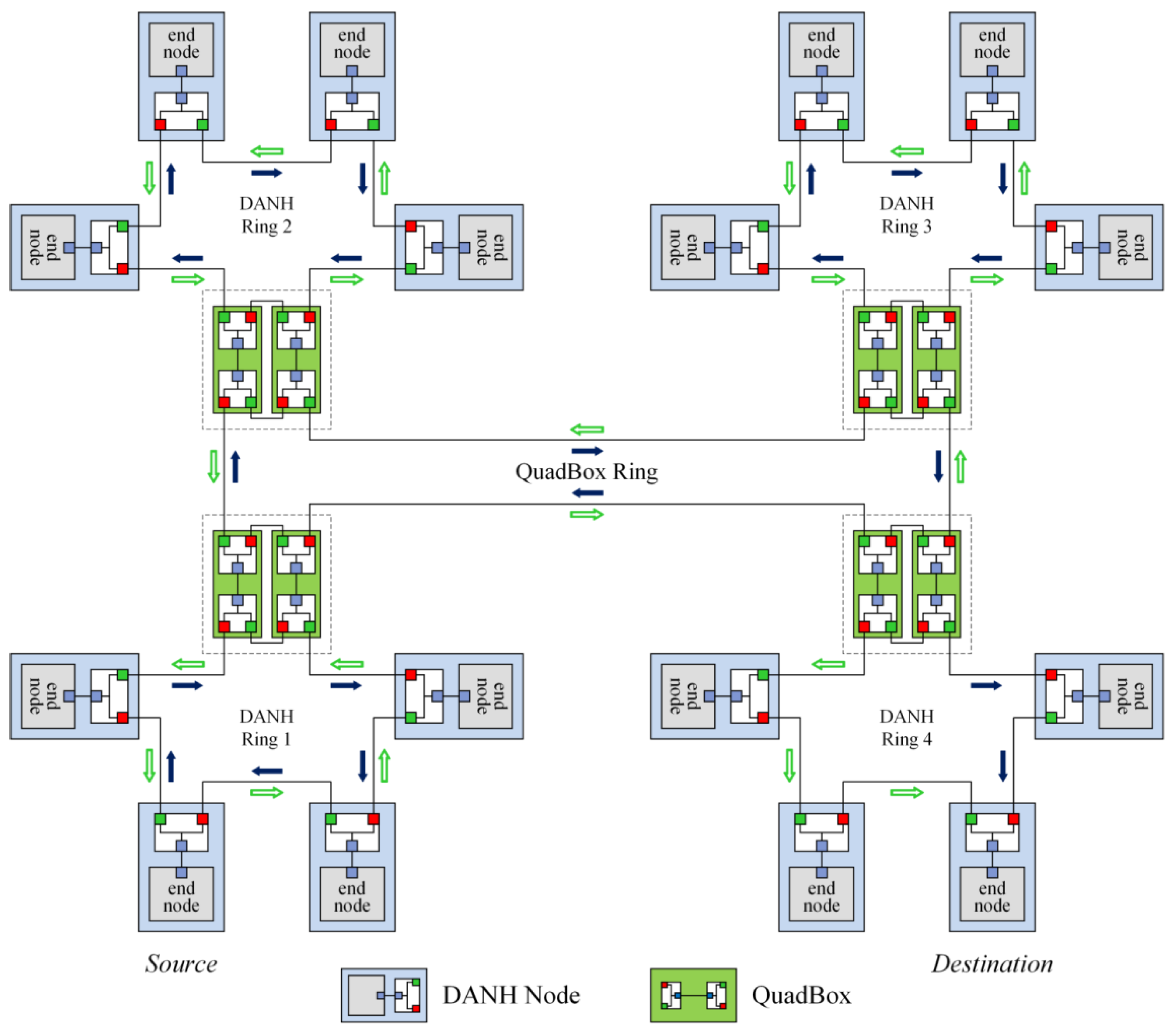
2.2. HSR Issues
- (1)
- Aside from ring topologies, the IEC 62439-3 briefly mentions other topologies to which the standard HSR can be applied. However, with current specifications and devices specified and defined in the current IEC 62439-3 standard [8], the standard HSR protocol is mainly used to provide seamless redundancy for ring-based topologies.
- (2)
- The second issue with respect to HSR is that it generates too much unnecessary redundant traffic in HSR networks. According to the forwarding rule of the standard HSR protocol, HSR nodes including DANH, RedBox and QuadBox nodes forward unicast frames from one port to other ports, unless they have already sent the same frame in that direction. The forwarding rule creates network traffic frames that circulate and double in HSR rings, as shown in Figure 2. The issue degrades the network performance and may cause network congestion and delay.
3. The Proposed SwitchBox
3.1. SwitchBox Concepts
3.1.1. Definition
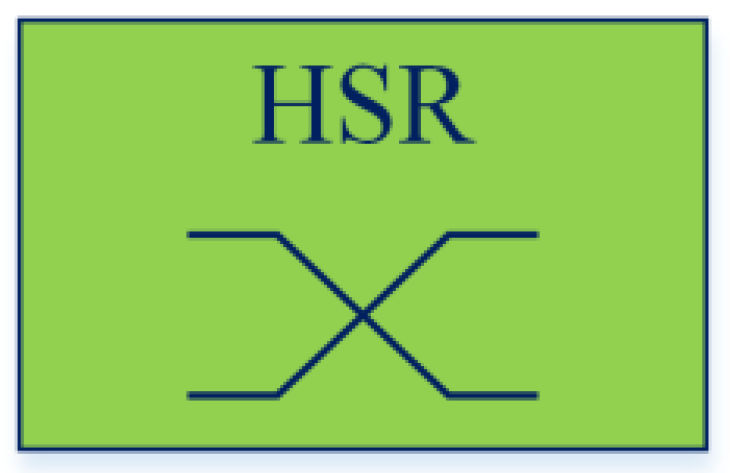
- Learning MAC addresses of HSR terminal nodes including DANH nodes and RedBox nodes that connect to the HSR SwitchBox directly or in a ring. Unlike the standard Ethernet switches that learn the MAC addresses of all Ethernet nodes, the HSR SwitchBox learns the MAC addresses of only HSR terminal nodes that connect to the SwitchBox.
- Building a MAC table that contains the MAC addresses of HSR terminal nodes that connect to the SwitchBox.
- Forwarding HSR frames based on the MAC table.
- Discarding duplicated HSR frames.
3.1.2. Port Types
- Access port: An access port is a port of an HSR SwitchBox that is connected to an HSR terminal node such as a DANH or a RedBox node.
- Trunk port: A trunk port is a port of an HSR SwitchBox that is connected to another SwitchBox.

3.1.3. Connections to HSR Terminal Nodes
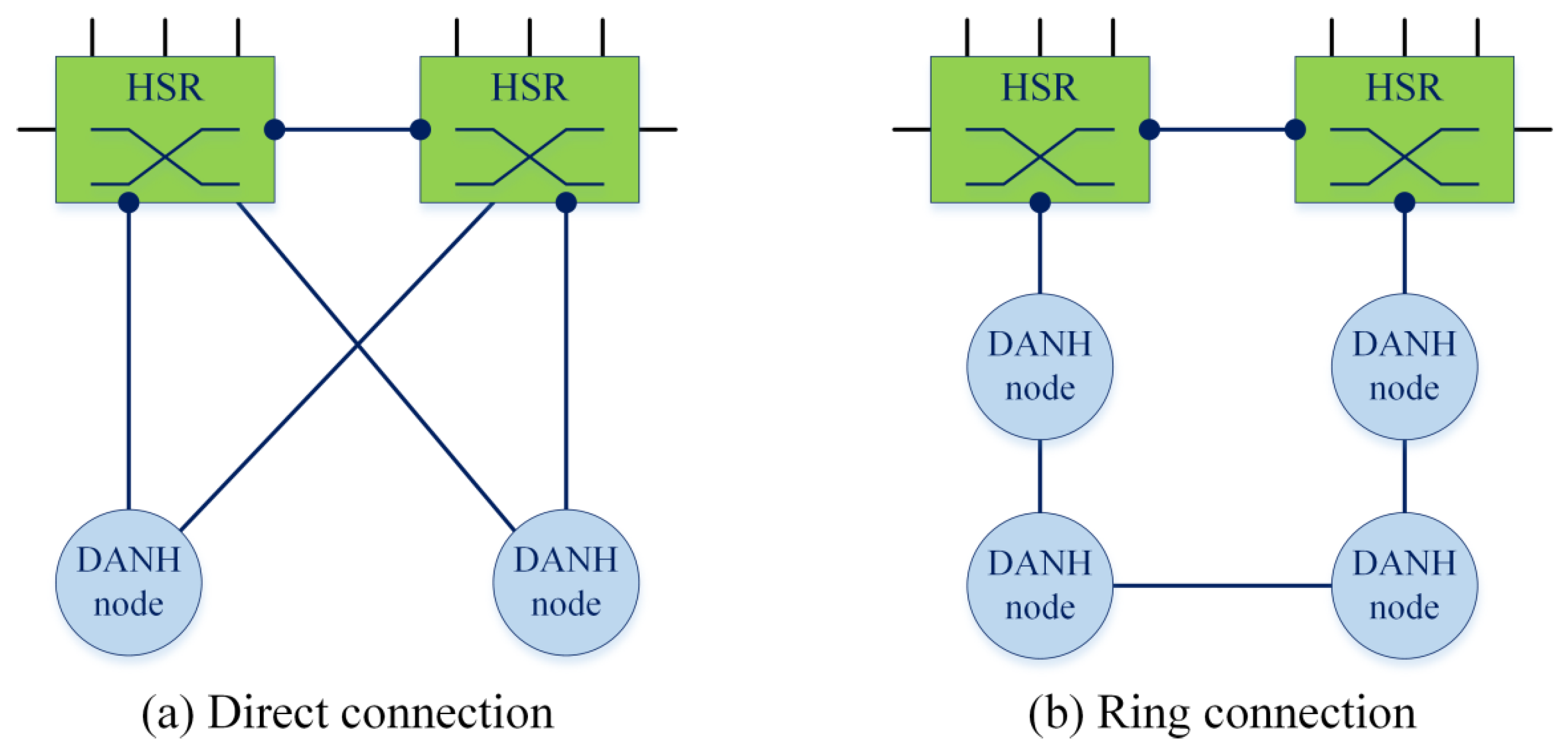
3.1.4. Forwarding Rule
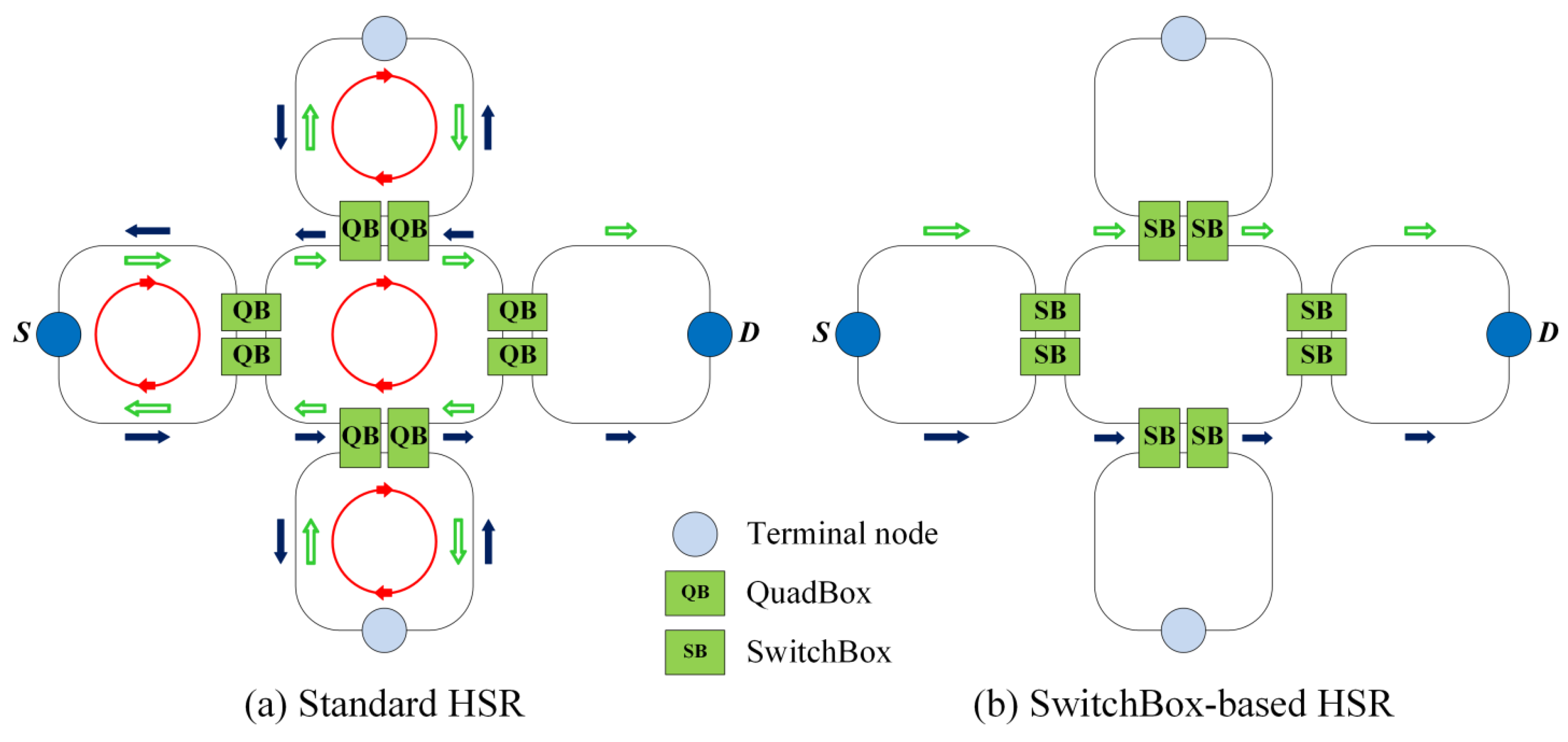
- Do not forward unicast frames to DANH rings that do not contain the destination of the frame.
- Forward unicast frames on all trunk links that are used to connect SwitchBoxes.
- Prevent traffic frames from doubling and circulating in rings.
3.2. Topologies
3.2.1. Ring Topology
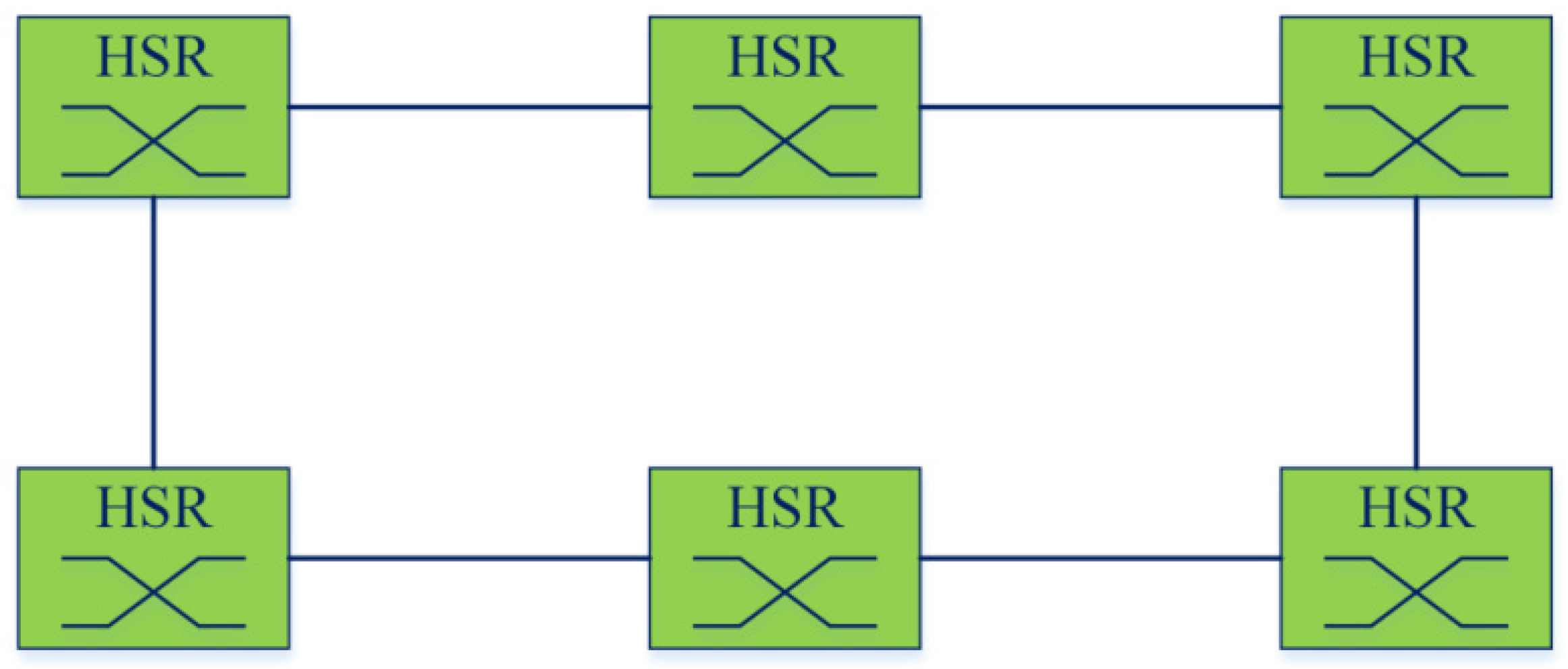
3.2.2. Mesh Topology
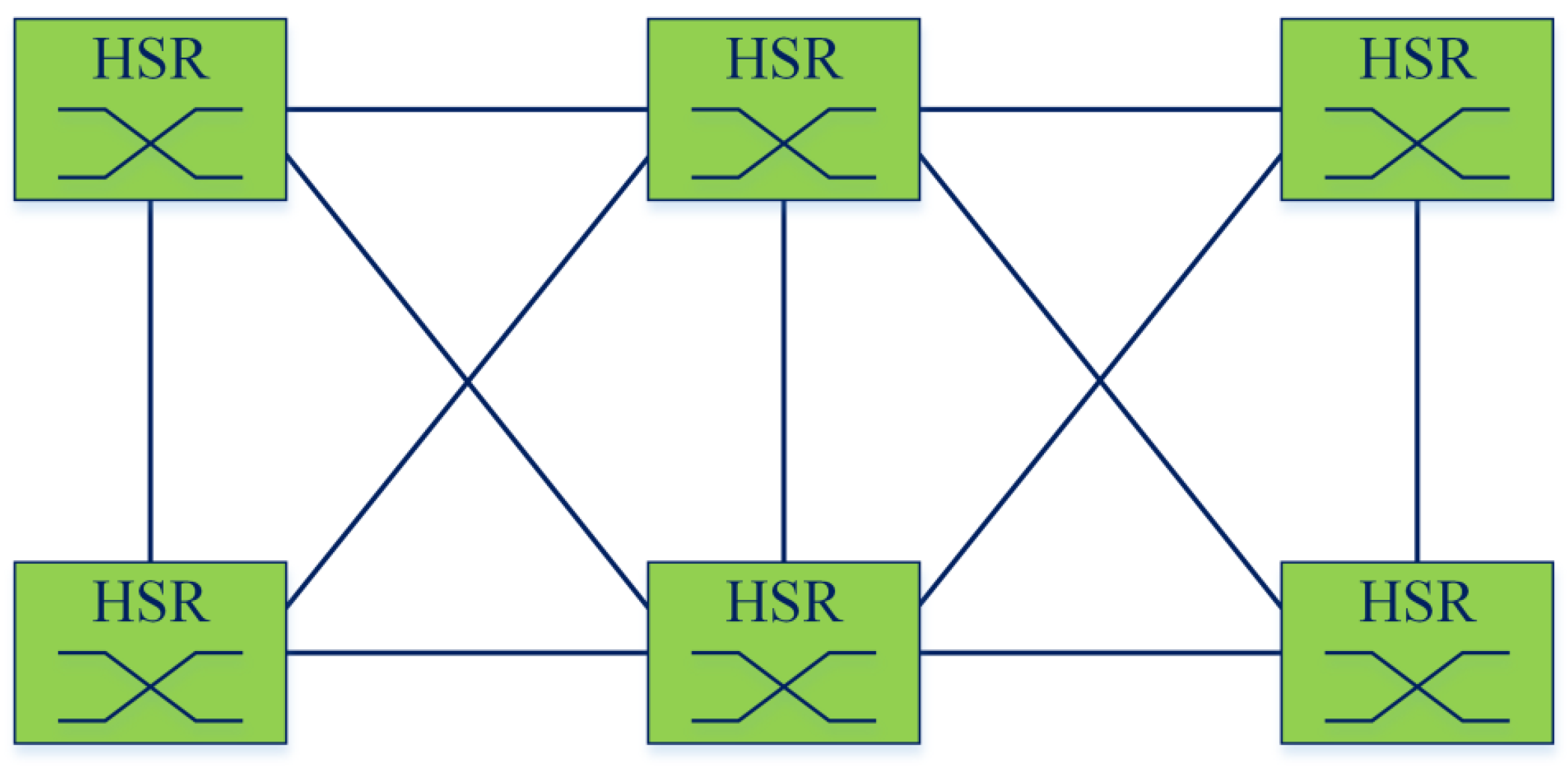
3.2.3. Star Topology
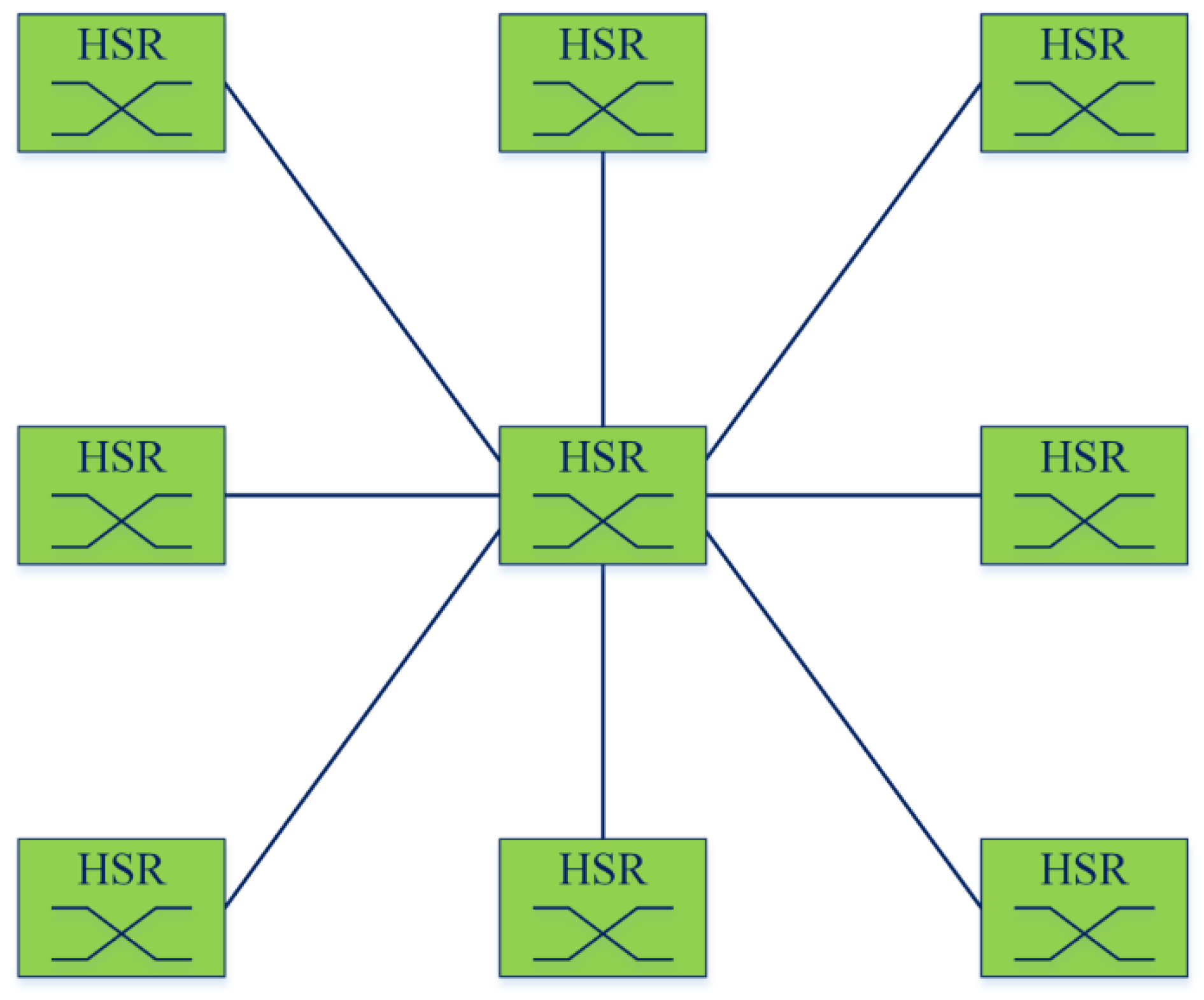
3.3. Operations
3.3.1. Setting Switch Port Type
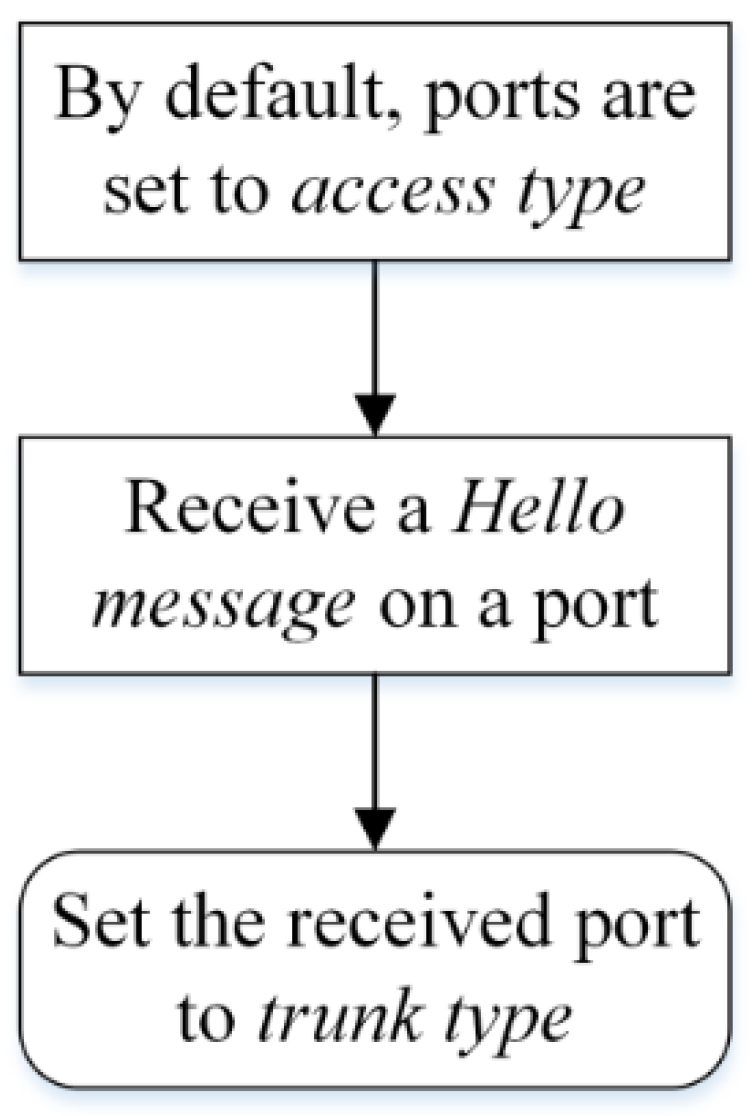
3.3.2. Learning Medium Access Control (MAC) Address
3.3.3. Building MAC Table
3.3.4. Forwarding Frames
Multicast and Broadcast Frames
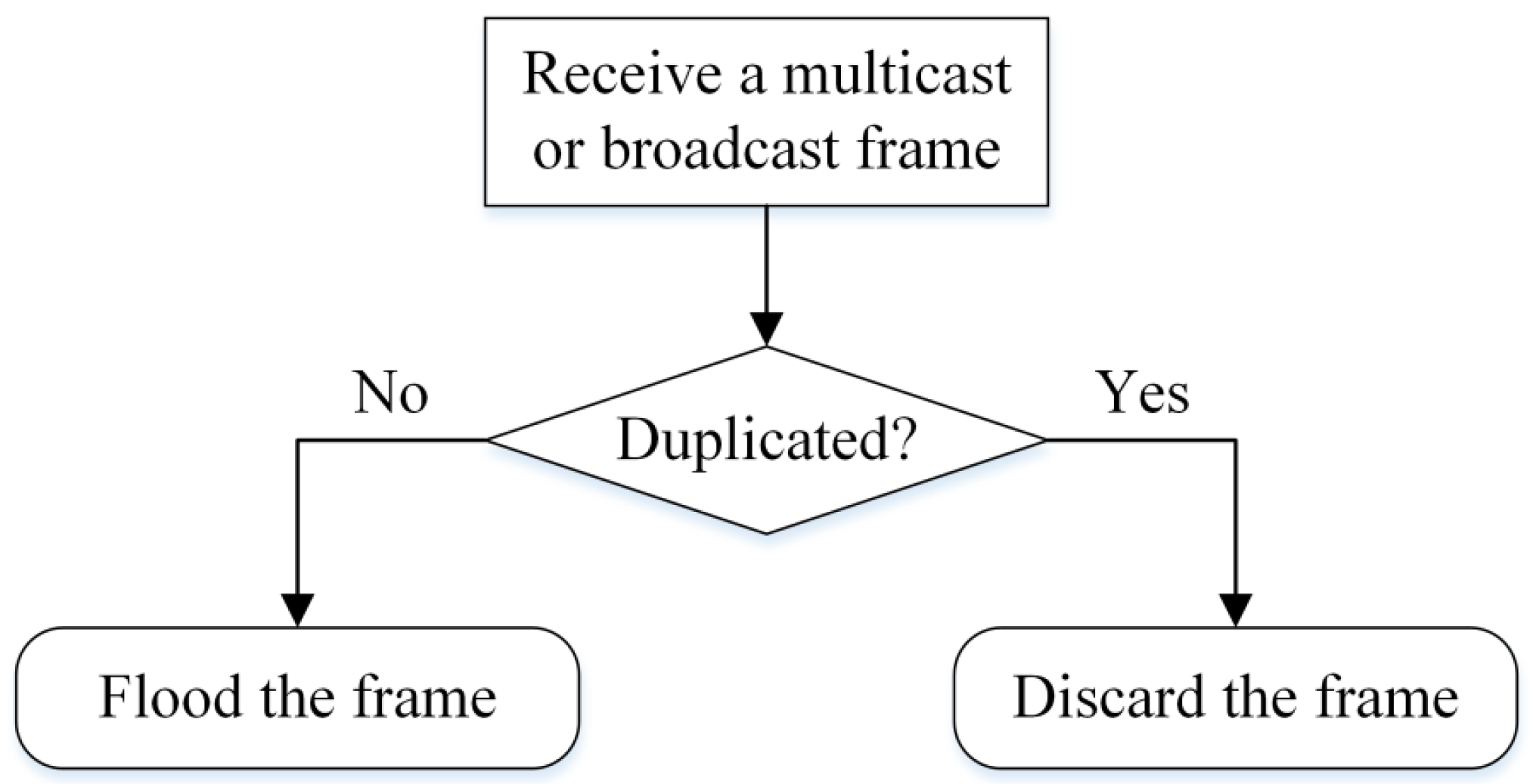
Unicast Frames
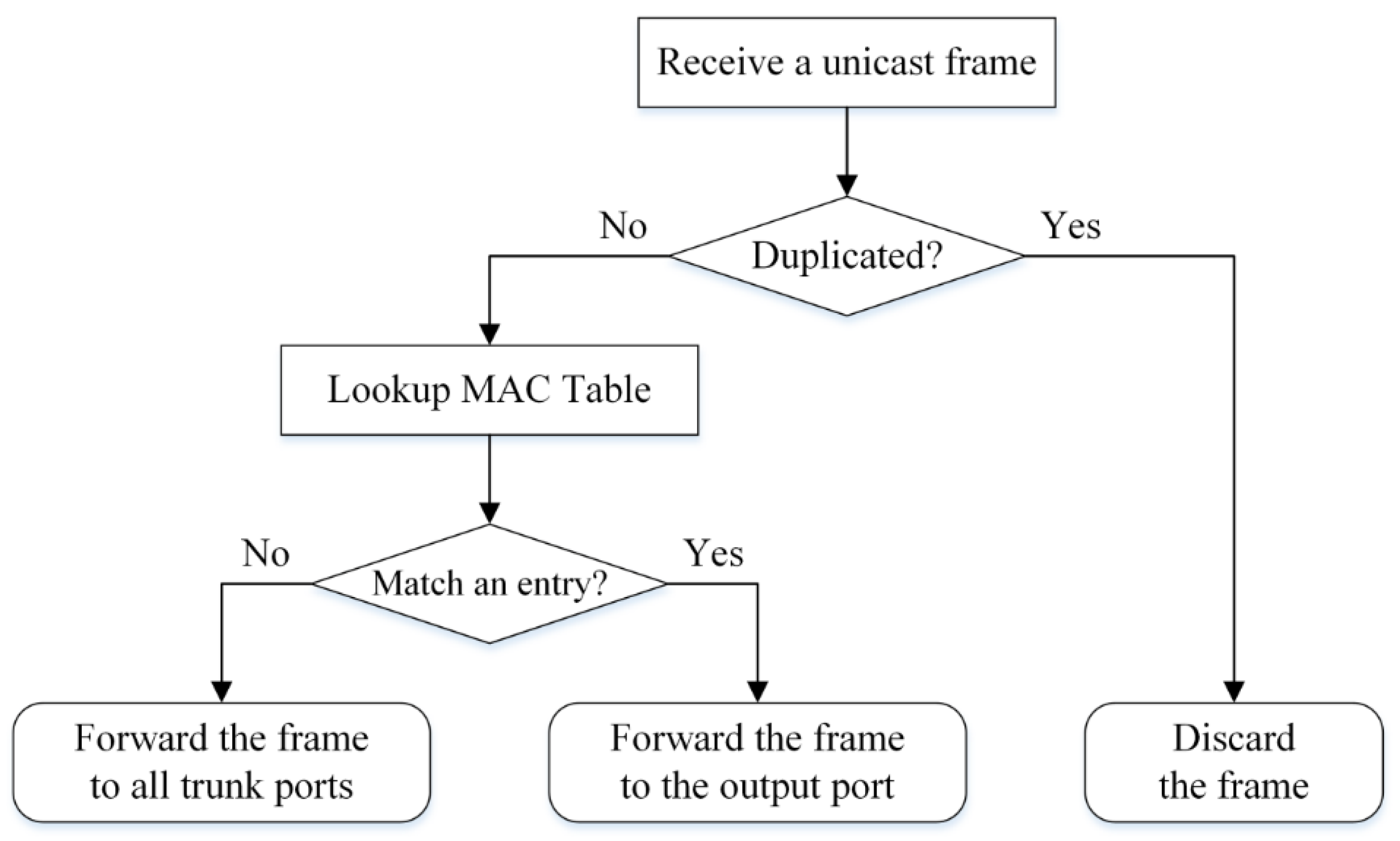



4. Performance Analysis
4.1. Redundancy Performance
4.1.1. Redundancy Performance under Rapid Spanning Tree Protocol (RSTP)

4.1.2. Redundancy Performance under SwitchBox-Based HSR

4.2. Traffic Performance
- Network unicast traffic: Network unicast traffic is the total number of unicast frame copies that are delivered on links and received by nodes when a source node sends unicast frames to a destination node in the network.
- Network broadcast traffic: Network broadcast traffic is the total number of broadcast frame copies that are delivered on links and received by nodes when a source node sends broadcast frames to the other nodes in the network.
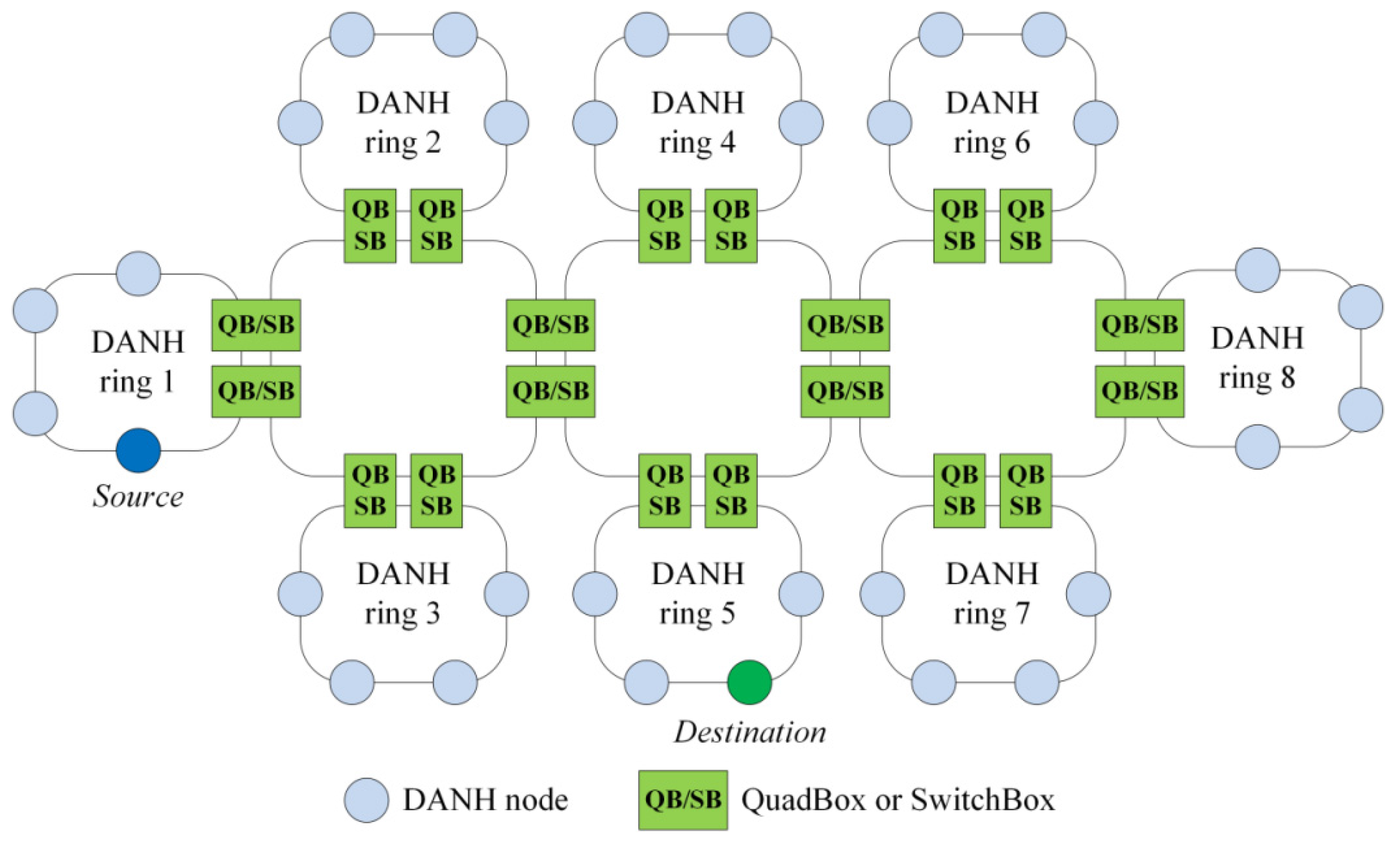
4.2.1. Notations
| Parameter | Description |
|---|---|
| Network traffic when a source node sends a frame under standard HSR | |
| Network traffic when a source node sends a frame under SwitchBox-based HSR | |
| Network traffic when a source node sends N frames under standard HSR | |
| Network traffic when a source node sends N frames under SwitchBox-based HSR | |
| A set of all rings in the network | |
| A set of all DANH rings | |
| A set of all DANH rings except the destination DANH ring | |
| A set of all QuadBox rings | |
| A set of all SwitchBox rings | |
| Total number of links in the source DANH ring | |
| Total number of links in the destination DANH ring | |
| Total number of links in the ith ring | |
| Total number of sent frames |
4.2.2. Under Standard HSR Protocol
Unicast Traffic
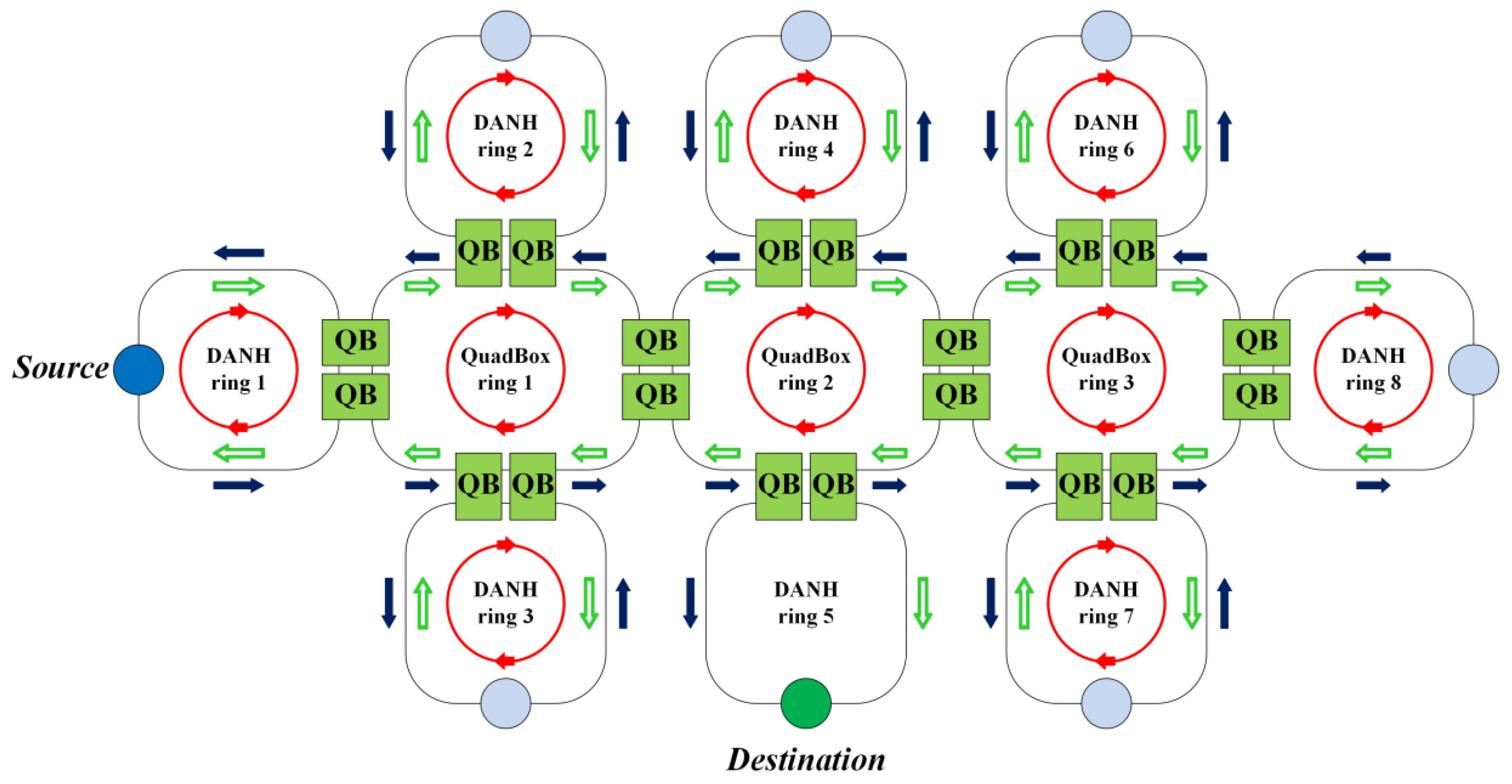
Multicast/Broadcast Traffic
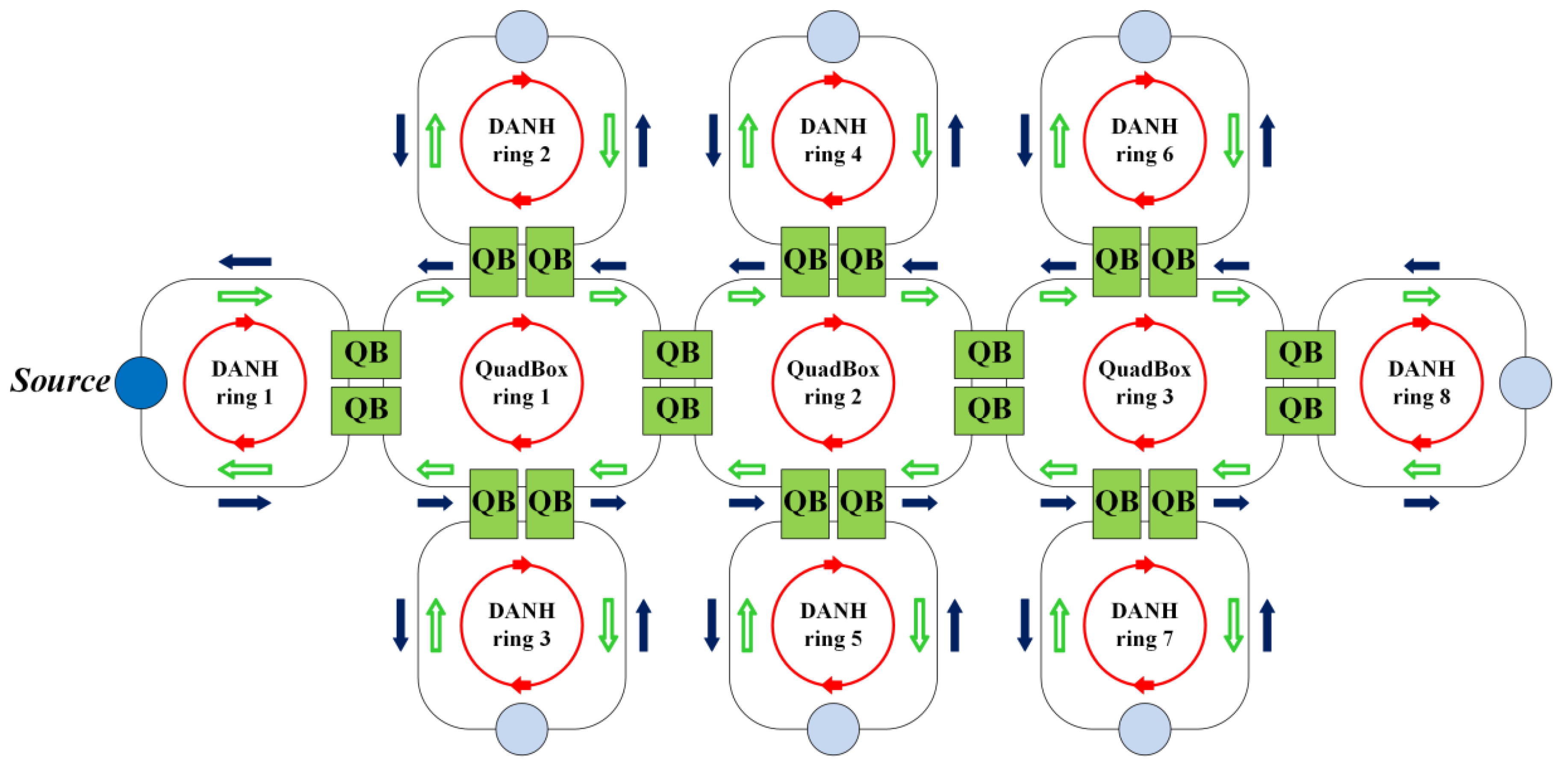
4.2.3. Under SwitchBox-Based HSR
Unicast Traffic
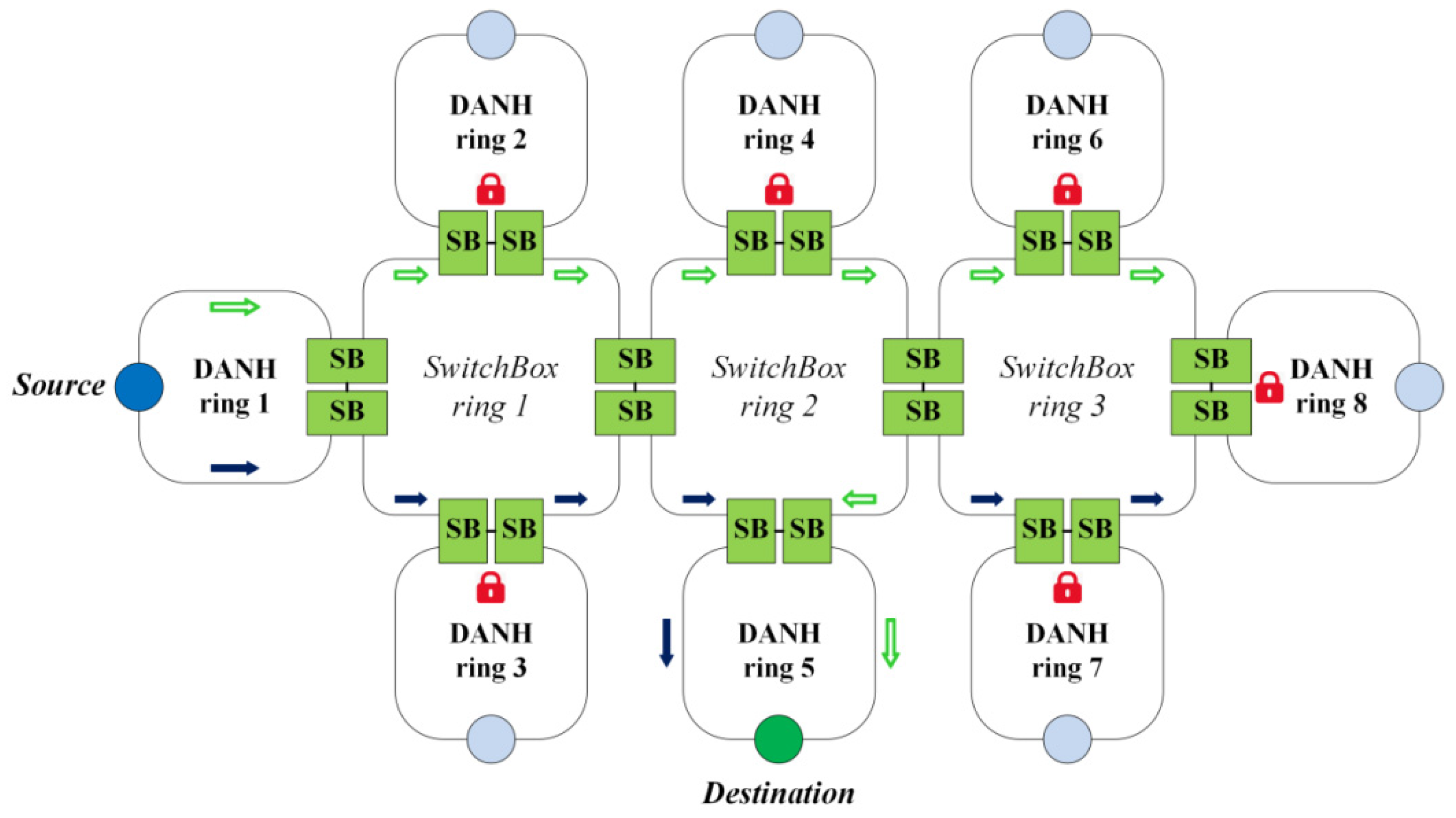
Multicast/Broadcast Traffic
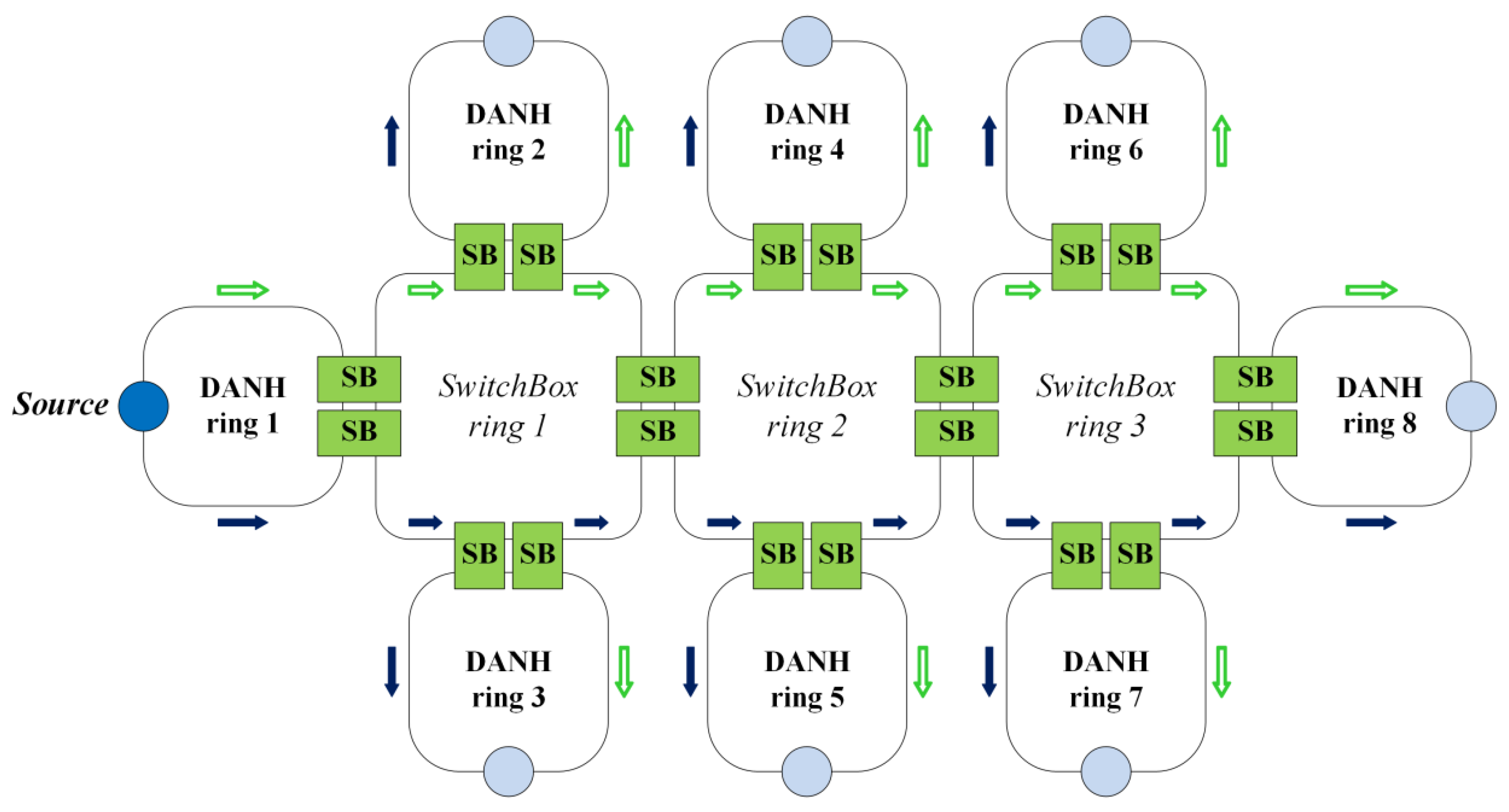
5. Simulations
5.1. Simulation Description
- Simulation 1: Validate seamless redundancy. This simulation was performed to validate the seamless redundancy provided by the SwitchBox-based HSR.
- Simulation 2: Validate the analyzed traffic performance. This simulation was conducted to validate the analyzed traffic performance described in Section 4.
- Simulation 3: Evaluate and compare traffic performance. This simulation was conducted to evaluate and compare the traffic performance of the SwitchBox-based HSR with that of the standard HSR.
5.1.1. Simulation 1: Validate Seamless Redundancy

5.1.2. Simulation 2: Validate the Analyzed Traffic Performance
5.1.3. Simulation 3: Evaluate and Compare the Traffic Performance
Case 1
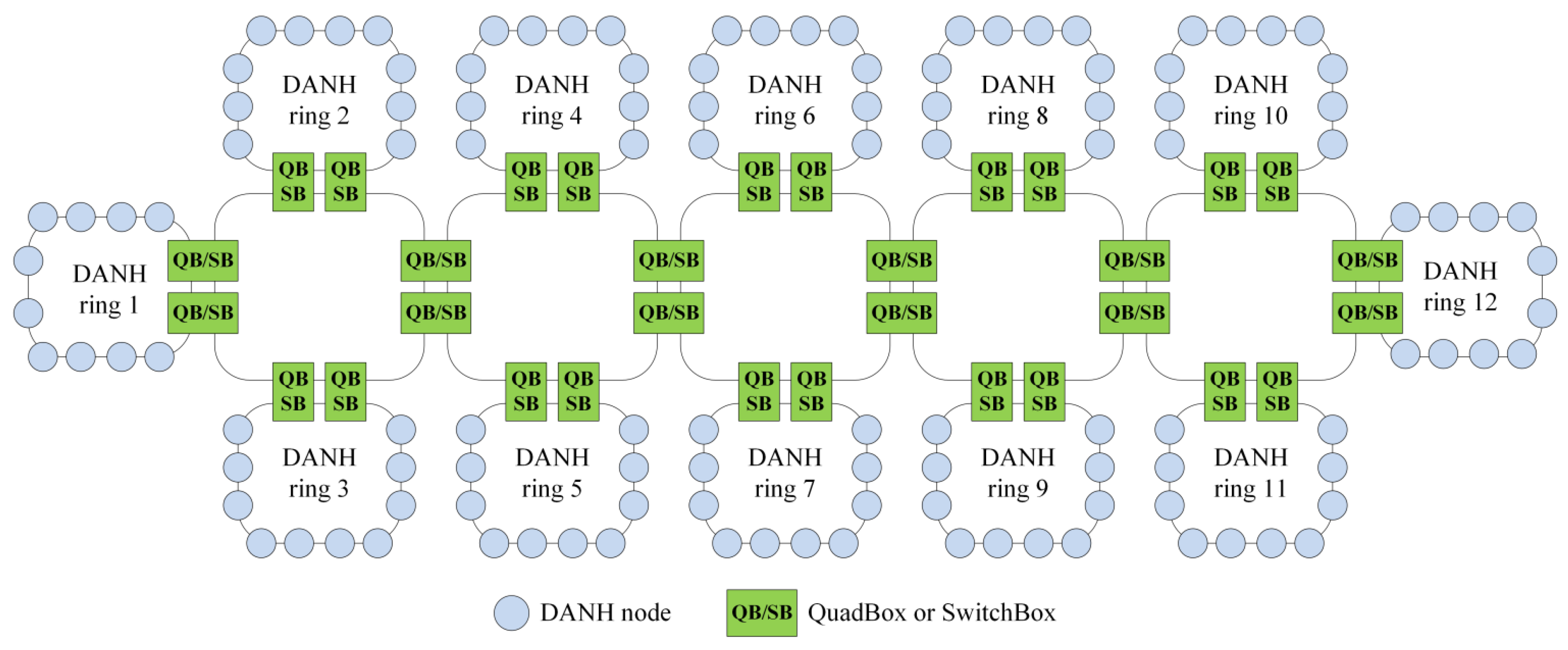
Case 2
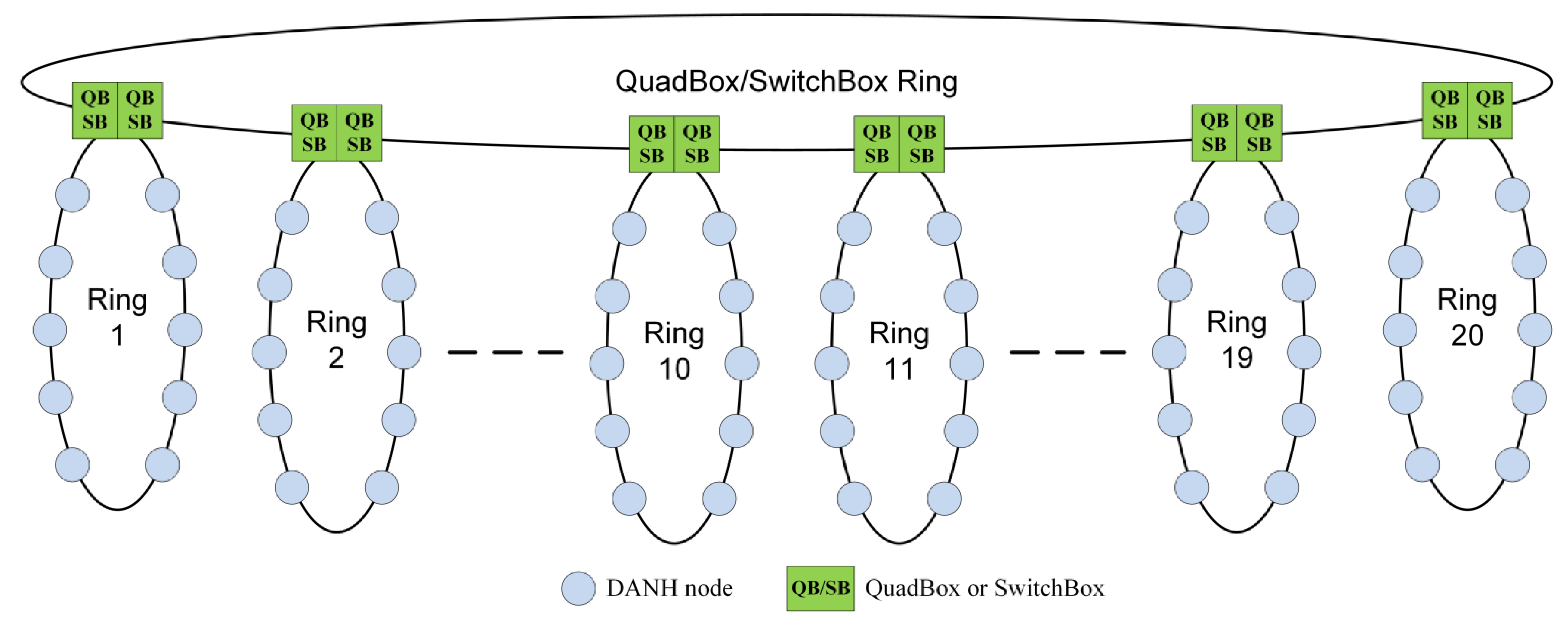
5.2. Simulation Results
5.2.1. Simulation 1
| Number of Sent Frames | Number of Received Frames | Number of Lost Frames |
|---|---|---|
| 10 | 10 | 0 |
| 20 | 20 | 0 |
| 30 | 30 | 0 |
| 40 | 40 | 0 |
| 50 | 50 | 0 |
| 60 | 60 | 0 |
| 70 | 70 | 0 |
| 80 | 80 | 0 |
| 90 | 90 | 0 |
| 100 | 100 | 0 |
5.2.2. Simulation 2
| Number of Sent Frames | Unicast Traffic | Broadcast Traffic | ||
|---|---|---|---|---|
| Standard HSR | SwitchBox-Based HSR | Standard HSR | SwitchBox-Based HSR | |
| 10 | 3570 | 610 | 3680 | 1850 |
| 20 | 7140 | 1220 | 7360 | 3700 |
| 30 | 10,710 | 1830 | 11,040 | 5550 |
| 40 | 14,280 | 2440 | 14,720 | 7400 |
| 50 | 17,850 | 3050 | 18,400 | 9250 |
| 60 | 21,420 | 3660 | 22,080 | 11,100 |
| 70 | 24,990 | 4270 | 25,760 | 12,950 |
| 80 | 28,560 | 4880 | 29,440 | 14,800 |
| 90 | 32,130 | 5490 | 33,120 | 16,650 |
| 100 | 35,700 | 6100 | 36,800 | 18,500 |
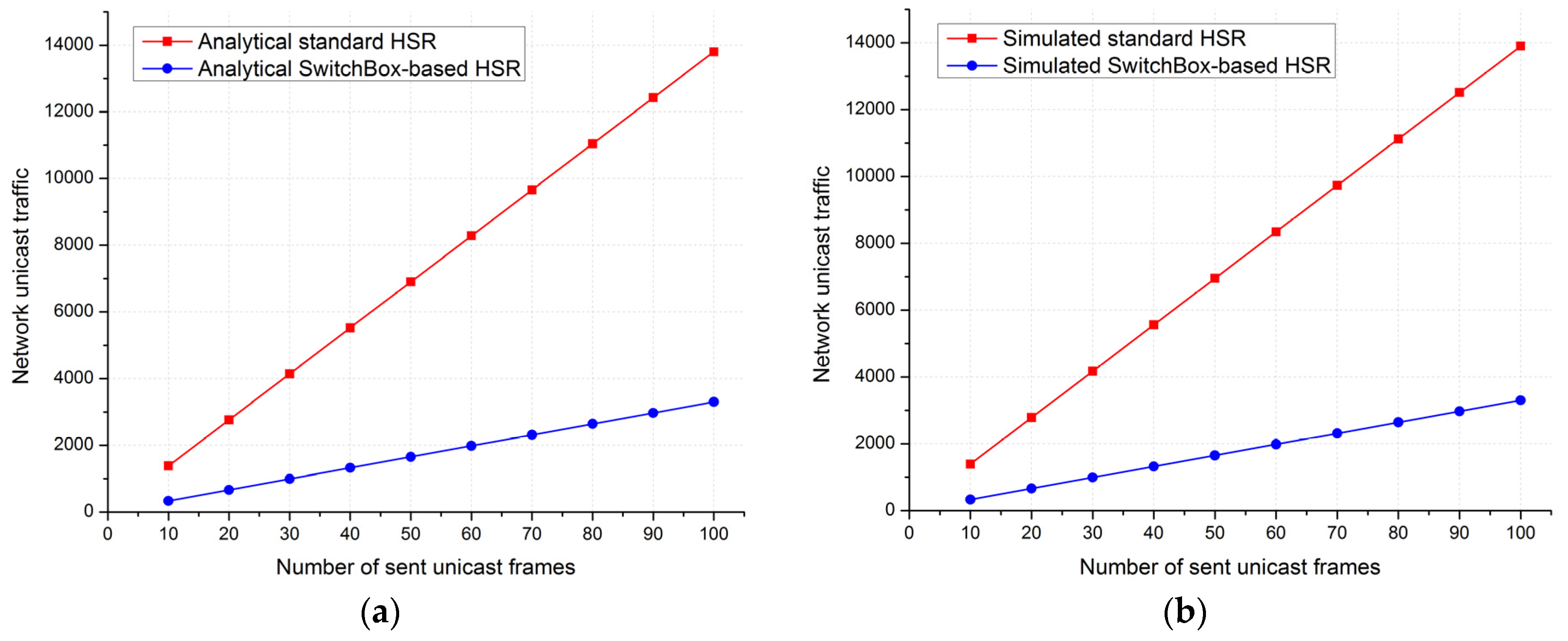
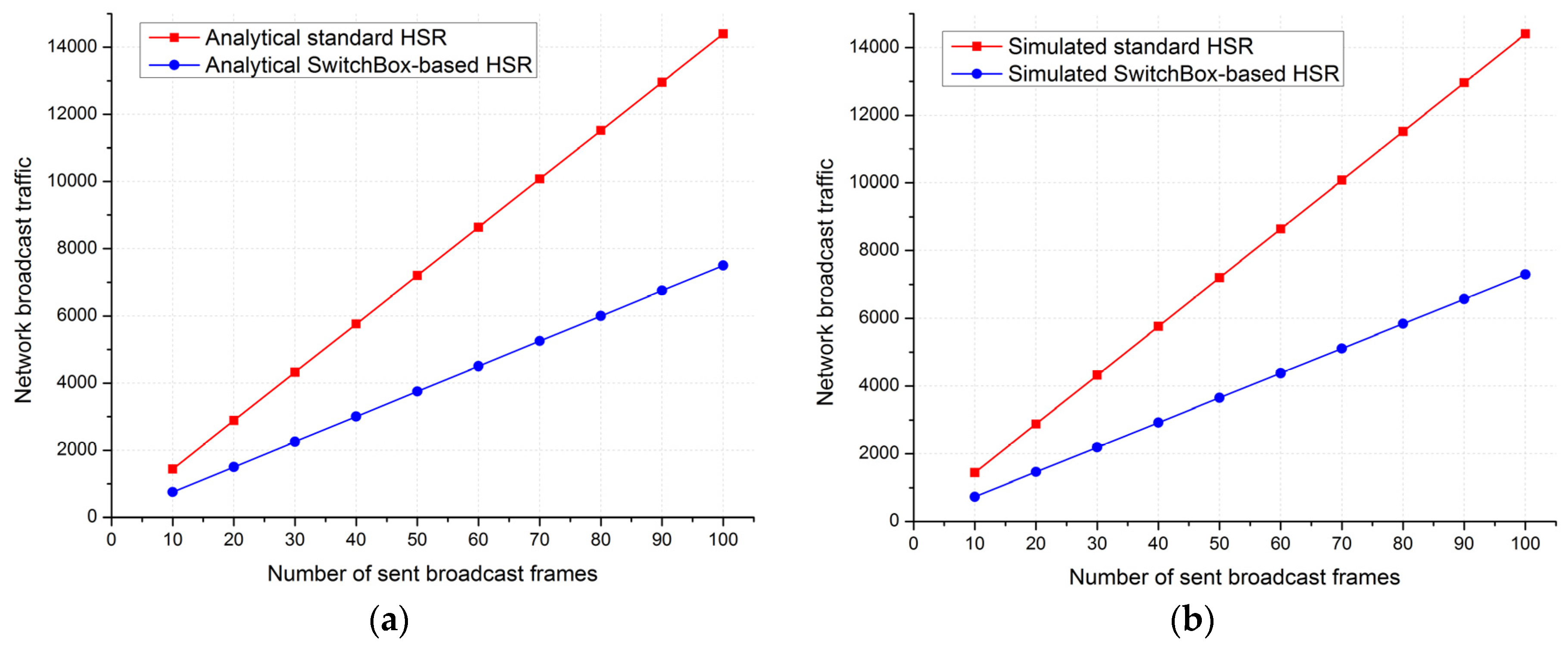
5.2.3. Simulation 3
| Number of Sent Frames | Unicast Traffic | Broadcast Traffic | ||
|---|---|---|---|---|
| Standard HSR | SwitchBox-Based HSR | Standard HSR | SwitchBox-Based HSR | |
| 10 | 3570 | 610 | 3680 | 1850 |
| 20 | 7140 | 1220 | 7360 | 3700 |
| 30 | 10,710 | 1830 | 11,040 | 5550 |
| 40 | 14,280 | 2440 | 14,720 | 7400 |
| 50 | 17,850 | 3050 | 18,400 | 9250 |
| 60 | 21,420 | 3660 | 22,080 | 11,100 |
| 70 | 24,990 | 4270 | 25,760 | 12,950 |
| 80 | 28,560 | 4880 | 29,440 | 14,800 |
| 90 | 32,130 | 5490 | 33,120 | 16,650 |
| 100 | 35,700 | 6100 | 36,800 | 18,500 |
| Number of Sent Frames | Unicast Traffic | Broadcast Traffic | ||
|---|---|---|---|---|
| Standard HSR | SwitchBox-Based HSR | Standard HSR | SwitchBox-Based HSR | |
| 10 | 5490 | 610 | 5600 | 2810 |
| 20 | 10,980 | 1220 | 11,200 | 5620 |
| 30 | 16,470 | 1830 | 16,800 | 8430 |
| 40 | 21,960 | 2440 | 22,400 | 11,240 |
| 50 | 27,450 | 3050 | 28,000 | 14,050 |
| 60 | 32,940 | 3660 | 33,600 | 16,860 |
| 70 | 38,430 | 4270 | 39,200 | 19,670 |
| 80 | 43,920 | 4880 | 44,800 | 22,480 |
| 90 | 49,410 | 5490 | 50,400 | 25,290 |
| 100 | 54,900 | 6100 | 56,000 | 28,100 |
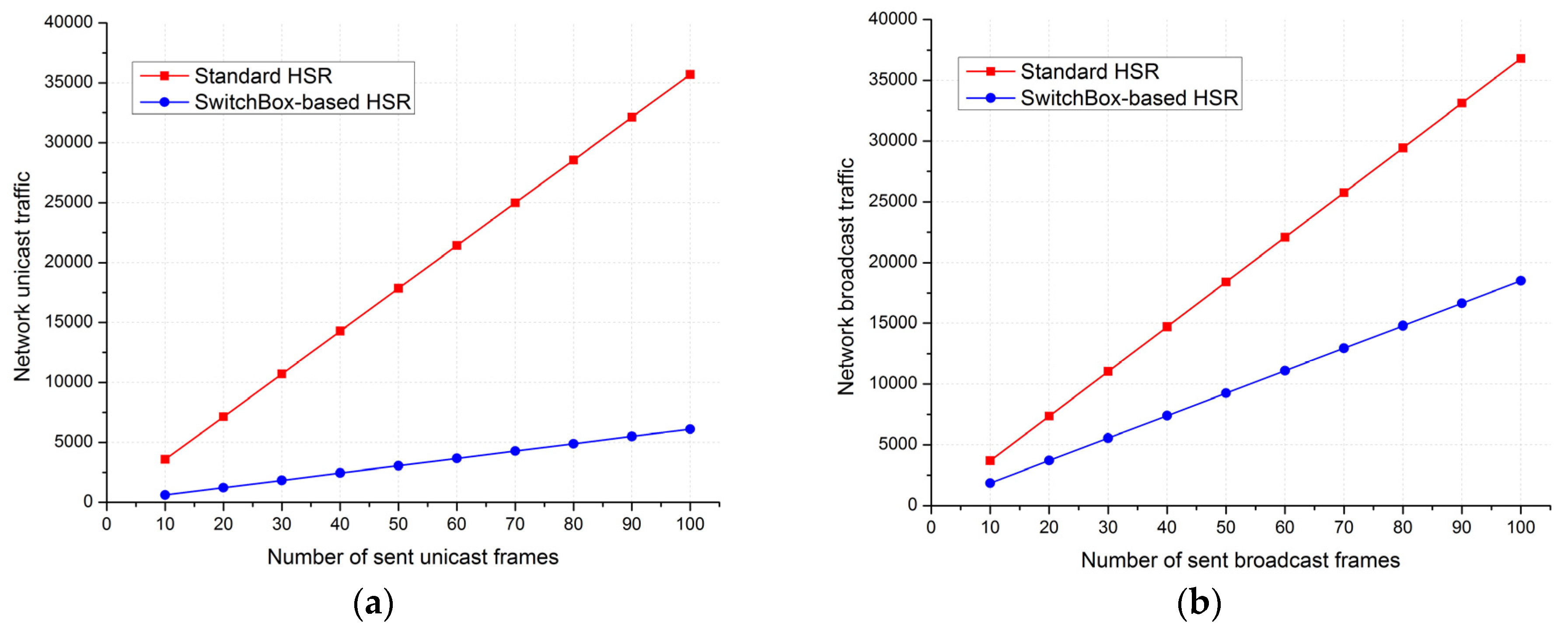

5.3. Discussion
| Protocol | Standard | Redundancy | Seamless Redundancy | Topology |
|---|---|---|---|---|
| RSTP | IEEE 802.1D-2004 [3] | Network | No | Any topology |
| MPR | IEC 62439-2 [4] | Network | No | Ring |
| PRP | IEC 62439-3 [8] | End nodes | Yes | Dual networks |
| Standard HSR | IEC 62439-3 [8] | End nodes | Yes | Ring |
| SwitchBox-based HSR | - | Network and end nodes | Yes | Any topology |
6. Conclusions
Acknowledgments
Author Contributions
Conflicts of Interest
References
- IEEE 802.3—IEEE Standards for Ethernet. Available online: http://www.ieee802.org/3/ (accessed on 30 June 2015).
- Decotignie, J.D. Ethernet-based real-time and industrial communications. IEEE Proc. 2004, 93, 1102–1117. [Google Scholar] [CrossRef]
- IEEE 802.1D-2004—IEEE Standard for Local and Metropolitan Area Networks: Media Access Control (MAC) Bridges. Available online: http://www.ieee802.org/1/pages/802.1D-2003.html (accessed on 30 June 2015).
- International Electrotechnical Commission (IEC). Industrial Communications Networks: High-Availability Automation Networks, Part 2: Media Redundancy Protocol (MRP); IEC 62439-2; The International Electrotechnical Commission: Geneva, Switzerland, 2010. [Google Scholar]
- Huynh, M.; Goose, S.; Mohapatra, P.; Liao, R. RRR: Rapid ring recovery submillisecond decentralized recovery for ethernet ring. IEEE Trans. Comput. 2011, 60, 1561–1570. [Google Scholar] [CrossRef]
- IEEE Time-Sensitive Networking Task Group. Available online: http://www.ieee802.org/1/pages/tsn.html (accessed on 30 November 2015).
- Kehrer, S.; Kleineberg, O.; Heffernan, D. A comparison of Fault-Tolerance Concepts for IEEE 802.1 Time Sensitive Networks (TSN). In Proceedings of the 2014 IEEE Emerging Technology and Factory Automation (ETFA), Barcelona, Spain, 16–19 September 2014; pp. 1–8.
- International Electrotechnical Commission (IEC). Industrial Communications Networks: High-Availability Automation Networks, Part 3: Parallel Redundancy Protocol (PRP) and High-Availability Seamless Redundancy (HSR); IEC 62439-3; The International Electrotechnical Commission: Geneva, Switzerland, 2012. [Google Scholar]
- Prytz, G. Network Recovery Time Measurements of RSTP in an Ethernet Ring Topology. In Proceedings of the 2007 IEEE Conference on Emerging Technologies and Factory Automation (ETFA2007), Patras, Greece, 25–28 September 2007; pp. 1247–1253.
- Giorgetti, A.; Cugini, F.; Paolucci, F.; Valcarenghi, L.; Pistone, A.; Castoldi, P. Performance analysis of media redundancy protocol (MRP). IEEE Trans. Ind. Inform. 2013, 9, 218–227. [Google Scholar] [CrossRef]
- IEEE Audio and Video Bridging Task Group. Available online: http://www.ieee802.org/1/pages/avbridges.html (accessed on 30 November 2015).
- Kirrmann, H.; Weber, K.; Kleineberg, O.; Weibel, H. HSR: Zero recovery time and low-cost redundancy for Industrial Ethernet (High availability seamless redundancy, IEC 62439-3). In Proceedings of the 2009 IEEE Conference on Emerging Technologies & Factory Automation (ETFA2009), Mallorca, Spain, 22–25 September 2009; pp. 1–4.
- International Electrotechnical Commission (IEC). Network Engineering Guidelines for Communication Networks and Systems in Substations; IEC 61850-90-4; The International Electrotechnical Commission: Geneva, Switzerland, 2013. [Google Scholar]
- International Electrotechnical Commission (IEC). Industrial Communications Networks—High-Availability Automation Networks, Part 1: General Concepts and Calculation Methods; IEC 62439-1; The International Electrotechnical Commission: Geneva, Switzerland, 2010. [Google Scholar]
- Nsaif, S.A.; Rhee, J.M. Improvement of high-availability seamless redundancy HSR traffic performance for smart grid communications. J. Commun. Netw. 2012, 14, 653–661. [Google Scholar] [CrossRef]
- Shin, M.; Joe, I. Performance improvement for the HSR ring protocol with traffic control in smart grid. In Proceedings of the 2012 Future Generation Information Technology Conference (FGIT), Gangwon, Korea, 16–19 December 2012; pp. 48–55.
- Abdulsalam, I.R.; Rhee, J.M. Improvement of high-availability seamless redundancy (HSR) unicast traffic performance using port locking. In Proceedings of the Fourth World Congress on Software Engineering, Hong Kong, China, 3–4 December 2013.
- Hong, S.; Joe, I. A novel packet transmission scheme with different periods according to the HSR ring direction in smart grid. In Proceedings of the 2012 Future Generation Information Technology Conference (FGIT), Gangwon, Korea, 16–19 December 2012; pp. 95–102.
- Tien, N.X.; Rhee, J.M. FHT: A novel approach for filtering high-availability seamless redundancy (HSR) traffic. Energies 2015, 8, 6249–6274. [Google Scholar] [CrossRef]
- Ngo, H.D.; Yang, H.S.; Ham, D.W.; Rhee, J.M.; An, Y.H.; Han, J.R.; Lee, Y.J.; Lee, N.H. An improved High-availability Seamless Redundancy (HSR) for dependable Substation Automation System. In Proceedings of the 16th International Conference on Advanced Communication Technology (ICACT), Pyeongchang, Korea, 16–19 February 2014.
- Tien, N.X.; Nsaif, S.A.; Rhee, J.M. High-Availability Seamless Redundancy (HSR) traffic reduction using optimal dual paths (ODP). In Proceedings of the International Conference on Green and Human Information Technology (ICGHIT), DaNang, Vietnam, 4–6 February 2015.
- OMNeT++ Version 4.6 Simulator. Available online: http://www.omnetpp.org/ (accessed on 15 June 2015).
© 2016 by the authors; licensee MDPI, Basel, Switzerland. This article is an open access article distributed under the terms and conditions of the Creative Commons by Attribution (CC-BY) license (http://creativecommons.org/licenses/by/4.0/).
Share and Cite
Tien, N.X.; Rhee, J.M. Developing a New HSR Switching Node (SwitchBox) for Improving Traffic Performance in HSR Networks. Energies 2016, 9, 36. https://doi.org/10.3390/en9010036
Tien NX, Rhee JM. Developing a New HSR Switching Node (SwitchBox) for Improving Traffic Performance in HSR Networks. Energies. 2016; 9(1):36. https://doi.org/10.3390/en9010036
Chicago/Turabian StyleTien, Nguyen Xuan, and Jong Myung Rhee. 2016. "Developing a New HSR Switching Node (SwitchBox) for Improving Traffic Performance in HSR Networks" Energies 9, no. 1: 36. https://doi.org/10.3390/en9010036
APA StyleTien, N. X., & Rhee, J. M. (2016). Developing a New HSR Switching Node (SwitchBox) for Improving Traffic Performance in HSR Networks. Energies, 9(1), 36. https://doi.org/10.3390/en9010036






